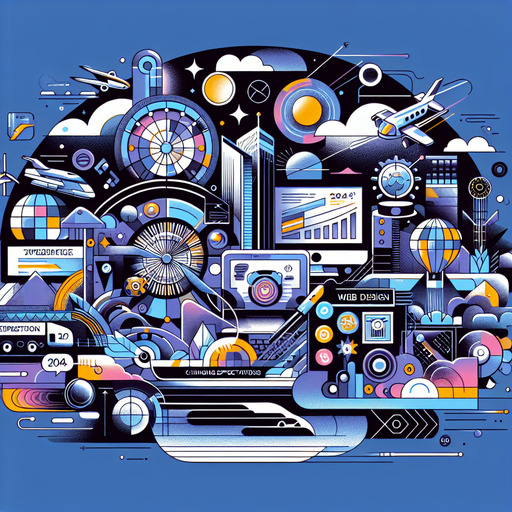
-
Table of Contents
Discover the Future of Web Design: Explore the Top Trends for 2024 Now! Learn More
Introduction
As we approach 2024, the landscape of web design continues to evolve, driven by technological advancements and changing user expectations. This year promises to bring a blend of innovative aesthetics, enhanced functionality, and a deeper focus on user experience. From the integration of AI-driven personalization to the rise of immersive 3D elements, web designers are set to explore new horizons. Sustainability and accessibility will also take center stage, reflecting a growing awareness of social responsibility in the digital realm. As businesses and creators strive to captivate and engage their audiences, understanding the upcoming trends in web design will be crucial for staying ahead in the competitive online environment.
Web Design Trends for 2024: What to Expect
As we approach 2024, the landscape of web design continues to evolve, driven by technological advancements and changing user expectations. One of the most significant trends anticipated for the coming year is the increased emphasis on immersive experiences. Virtual reality (VR) and augmented reality (AR) are no longer confined to gaming and entertainment; they are making substantial inroads into web design. Websites are expected to leverage these technologies to create more engaging and interactive user experiences, allowing visitors to explore products and services in a more tangible and realistic manner.
In tandem with immersive experiences, the rise of artificial intelligence (AI) and machine learning (ML) is set to revolutionize web design. AI-driven personalization will enable websites to offer tailored content and recommendations based on user behavior and preferences. This level of customization not only enhances user satisfaction but also increases engagement and conversion rates. Moreover, AI-powered chatbots and virtual assistants will become more sophisticated, providing instant support and improving overall user experience.
Another trend gaining momentum is the focus on accessibility and inclusivity. As the internet becomes an integral part of daily life, ensuring that websites are accessible to all users, including those with disabilities, is paramount. Designers are expected to adopt best practices such as using semantic HTML, providing alternative text for images, and ensuring keyboard navigability. Additionally, the use of inclusive language and diverse imagery will help create a more welcoming and representative online environment.
Sustainability is also emerging as a crucial consideration in web design. With growing awareness of environmental issues, designers are looking for ways to reduce the carbon footprint of websites. This includes optimizing images and videos, minimizing the use of heavy scripts, and implementing efficient coding practices. By creating lightweight and energy-efficient websites, designers can contribute to a more sustainable digital ecosystem.
The trend towards minimalism and simplicity in design is expected to continue in 2024. Clean, uncluttered interfaces with ample white space not only enhance aesthetic appeal but also improve usability. Users are increasingly drawn to websites that offer a straightforward and intuitive navigation experience. This minimalist approach extends to typography as well, with a preference for simple, readable fonts that enhance content clarity.
Furthermore, the integration of micro-interactions is set to enhance user engagement. These subtle animations and feedback mechanisms, such as hover effects and loading indicators, provide users with immediate responses to their actions, making the browsing experience more interactive and enjoyable. Micro-interactions can guide users through a website, highlight important information, and create a sense of delight.
The growing importance of mobile-first design cannot be overstated. With the majority of web traffic now coming from mobile devices, ensuring that websites are optimized for smaller screens is essential. Responsive design techniques, such as flexible grids and scalable images, will continue to be crucial. Additionally, the use of progressive web apps (PWAs) is expected to rise, offering users a seamless and app-like experience on mobile devices without the need for downloads.
Lastly, the integration of advanced data visualization techniques is anticipated to become more prevalent. As data becomes increasingly complex, presenting it in a clear and comprehensible manner is vital. Interactive charts, graphs, and infographics will help users make sense of large datasets, enhancing their understanding and engagement.
In conclusion, the web design trends for 2024 reflect a dynamic and user-centric approach, driven by technological innovation and a commitment to inclusivity and sustainability. By embracing these trends, designers can create websites that not only meet the evolving needs of users but also contribute to a more engaging and responsible digital landscape.
Q&A
1. **What are the expected web design trends for 2024?**
– **Dark Mode Dominance**: Increased use of dark mode for better user experience and energy efficiency.
– **AI and Machine Learning Integration**: Enhanced personalization and interactivity through AI-driven content and design elements.
– **3D and Immersive Experiences**: More 3D elements and immersive web experiences using AR/VR technologies.
– **Minimalism and Simplified Navigation**: Clean, simple designs with intuitive navigation to improve usability.
– **Micro-Interactions**: Subtle animations and interactions to engage users and provide feedback.
– **Sustainability and Eco-Friendly Design**: Focus on energy-efficient design practices and promoting sustainability.
– **Voice User Interface (VUI)**: Increased integration of voice search and commands for hands-free navigation.
– **Neumorphism**: A blend of skeuomorphism and flat design for a soft, realistic look.
– **Inclusive Design**: Greater emphasis on accessibility and inclusivity in web design.
– **Advanced Typography**: Creative and bold typography to make content stand out.